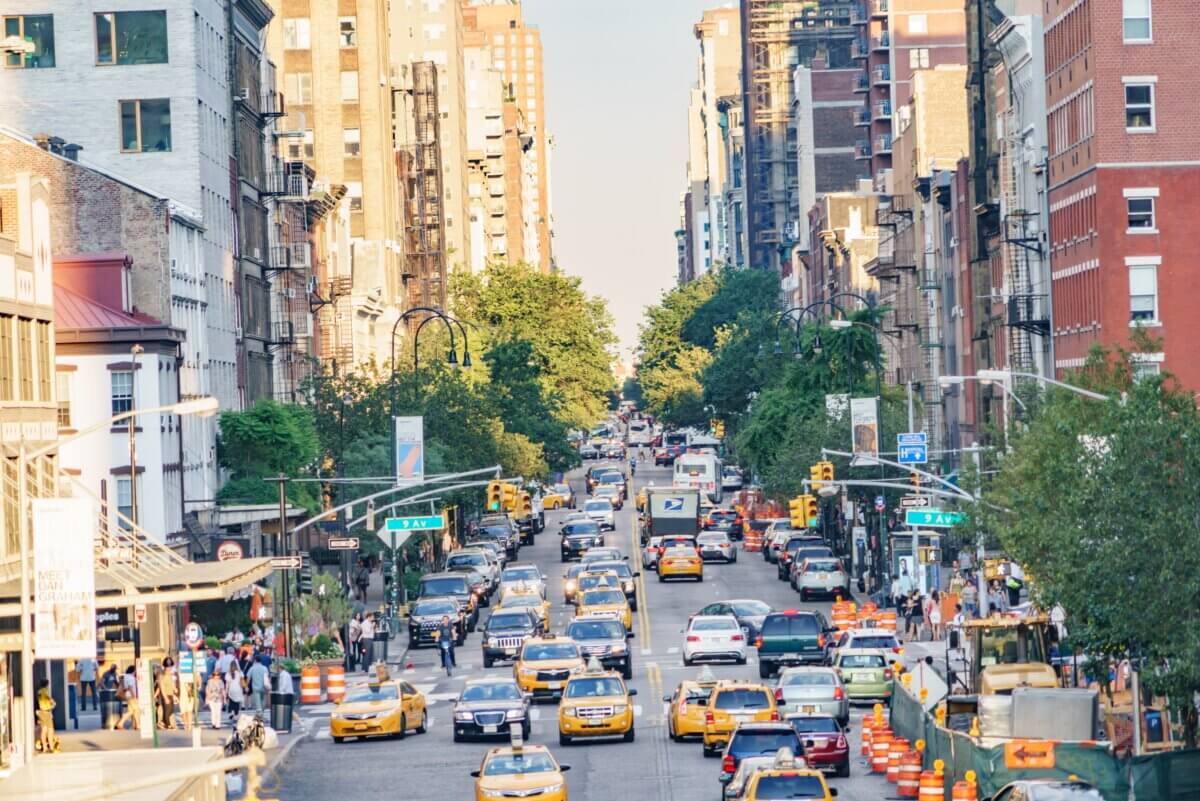
(Photo by Mulevich on Shutterstock)
New study shows the stress-relieving effects from nature sounds are minimal when there’s traffic noise mixed in
BRISTOL, England — There’s a mental health treatment happening right outside your window – if you can hear it over the traffic. Scientists have quantified what bird enthusiasts have long suspected: natural soundscapes can significantly reduce stress and anxiety, but only when they’re not competing with the roar of rapid transit.
The research, conducted by scientists at the University of the West of England, comes at a crucial time when cities worldwide are debating the merits of reducing speed limits. While these discussions typically center around safety concerns, this study suggests that slower traffic speeds could offer an unexpected benefit: allowing urban dwellers to better experience the therapeutic effects of nature’s symphony.
The study’s findings, published in PLOS ONE, paint a clear picture: when people can hear natural sounds without the interference of high-speed traffic noise, they experience lower levels of stress and anxiety. However, this calming effect diminishes as traffic speeds – and their accompanying noise levels – increase. It’s like trying to appreciate a Mozart symphony while someone runs a vacuum cleaner; the underlying beauty gets lost in the mechanical cacophony.
Sounding off
The research team recruited 68 university students for their experiment, carefully designing a series of tests to measure how different soundscapes affected participants’ mood and stress levels. Each participant went through three rounds of exposure to different sound combinations: pure natural sounds (including birdsong), natural sounds mixed with 20 mph traffic noise, and natural sounds combined with 40 mph traffic noise.

To ensure the results weren’t simply reflecting participants’ natural mood fluctuations, the researchers first exposed them to stress-inducing stimuli — think complicated math problems presented with flashing colors and irritating background noises (imagine trying to solve equations while someone repeatedly scrapes a fork against a plate). After this intentional stress induction, participants listened to the different soundscape combinations while researchers measured their anxiety and stress levels using standardized psychological scales.
Natural soundscapes alone proved most effective at reducing stress and anxiety, with participants reporting their lowest stress levels after listening to pure nature sounds. When 20 mph traffic noise was added to the mix, the calming effects were somewhat diminished but still present. However, when the faster 40 mph traffic noise was introduced, the therapeutic benefits of nature sounds were significantly masked, leading to higher reported levels of stress and anxiety.
Green spaces and slower paces
While cities have traditionally focused on creating green spaces, this research suggests that these areas need to be acoustically protected as well. It’s not enough to plant trees and hope for the best; we need to consider how traffic noise might be preventing people from fully experiencing the mental health benefits these natural spaces could offer.
The study’s results are particularly relevant for individuals who already struggle with anxiety. The researchers found that participants with higher baseline anxiety levels were more sensitive to the negative effects of traffic noise, suggesting that reducing urban noise pollution could be especially beneficial for those most vulnerable to stress-related mental health issues.
But there’s hope in these findings. The study suggests that implementing lower speed limits in urban areas could create what might be called “acoustic sanctuaries” – spaces where natural sounds can prevail over the mechanical chorus of city life. This aligns with a growing movement in urban planning that advocates for “20-minute cities,” where most daily needs can be met within a 20-minute walk from home, naturally encouraging slower traffic speeds.

The future of urban soundscapes might also be shaped by technological advances. The researchers note that the widespread adoption of electric vehicles could help create quieter urban environments where natural sounds can better penetrate. Combined with thoughtful urban planning that integrates green spaces along transit routes, cities could become not just more sustainable, but more sonically soothing as well.
As our world becomes increasingly urbanized, findings like these become ever more crucial. They remind us that in our rush to build bigger, faster cities, we might be drowning out one of nature’s most potent medicines: its soundtrack.
“Our study shows that listening to natural soundscapes can reduce stress and anxiety, and that anthropogenic sounds such as traffic noise can mask potential positive impacts. Reducing traffic speeds in cities is therefore an important step towards more people experiencing the positive effects of nature on their health and wellbeing,” the authors write.
In the end, perhaps the solution to some of our urban mental health challenges isn’t just about creating more green spaces – it’s about creating spaces where we can actually hear the green. After all, what good is a bird’s song if the sound of cars drown it out?
Paper Summary
Methodology
The researchers recruited 68 participants from the University of the West of England’s Psychology participant pool, student union survey page, and via email between March-April 2021. Each participant completed three experimental sections, with each section following the same pattern: exposure to a one-minute stressor video (featuring math questions obscured by flashing colors and stressful sounds like squeaky noises, annoying music, or alarm beeping), followed by mood assessment, then exposure to a three-minute soundscape, followed by another mood assessment.
The researchers created three soundscape recordings: a natural dawn chorus recorded in West Sussex featuring common UK bird species, the same natural soundscape mixed with traffic recorded on a 20 mph road in Bath, and the natural soundscape mixed with traffic from a 40 mph road. Traffic recordings were made between 8:30-9:00 a.m. at 1 meter from each road. While the soundscape order was randomized between participants, the stressor video order remained the same. Participants used either noise-cancelling headphones, earbuds, or computer speakers and were asked to adjust volume to a comfortable but immersive level.
Results
The findings showed a clear pattern: pure natural soundscapes resulted in the lowest anxiety scores (9.57 on the STAI-S scale) compared to mixed soundscapes with 20 mph traffic (10.87) and 40 mph traffic (11.32). Similar patterns emerged for stress levels. Importantly, there was no significant difference in stress levels between natural soundscapes and those mixed with 20 mph traffic, suggesting that slower traffic speeds might preserve some of nature’s beneficial effects.
Limitations
The study had several key limitations. First, participants were primarily white British female undergraduate students in their first or second year studying science, psychology, or social science, which limits the generalizability of findings to broader populations. Second, while the soundscapes included various bird species in the dawn chorus recording, the study did not examine how different levels of biodiversity in the soundscapes might affect responses. Third, most participants grew up in either semi-rural (39.71%) or urban (44.12%) environments, which could influence their responses to natural versus urban sounds. Fourth, while most participants used headphones (77.94% combined between in-ear and over-ear), 22% listened through laptop speakers, which could affect sound quality and immersion.
Additionally, the study excluded participants with diagnosed psychiatric conditions or those taking medication for anxiety and depression, as low mood and medication could influence subjective responses.
Discussion and Takeaways
The research suggests several practical applications: cities should consider reducing speed limits not just for safety but for mental health benefits; urban planners should design green spaces with acoustic protection in mind; and the transition to electric vehicles could offer additional mental health benefits beyond environmental ones. The study also highlights the importance of preserving natural soundscapes in urban environments and suggests that access to these acoustic environments could be particularly beneficial for individuals with anxiety.
Funding and Disclosures
The research team received no specific funding for this work, and they declared no competing interests. The study was conducted with ethical approval from the University of the West of England (approval code: HAS.20.11.036).








Most cars now get their best mileage between 40 and 45 mph. So slowing traffic increases fuel consumption and thus CO2 emissions. So which do you want? Noise pollution or air pollution?
What really destroys the calming effects that urban parks could otherwise have is sirens. Police cars, fire trucks, and ambulances are constantly disturbing the peace of residents. Ambulances especially seem to have become much more common in recent years, or at least are using their sirens more. This needs to stop. These sirens should be used only when really and truly needed. I can’t count how many times I have seen ambulances driving down empty roadways with their sirens blaring.